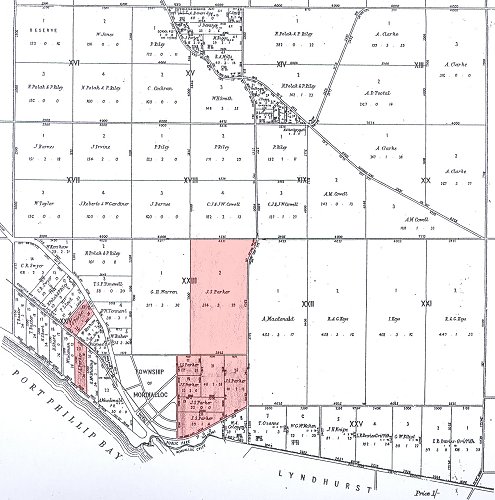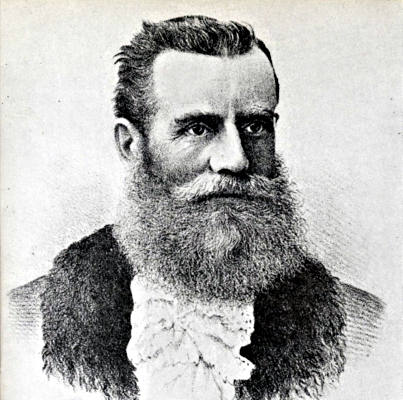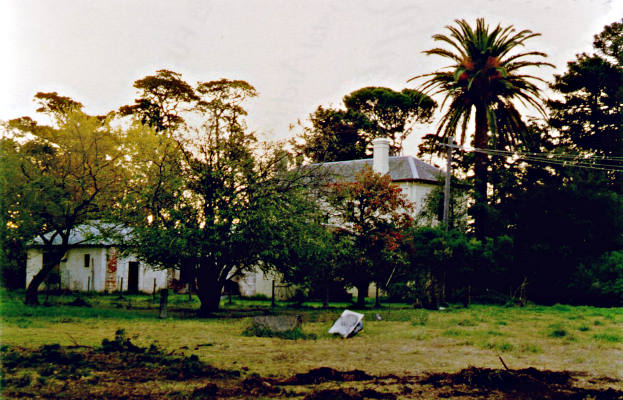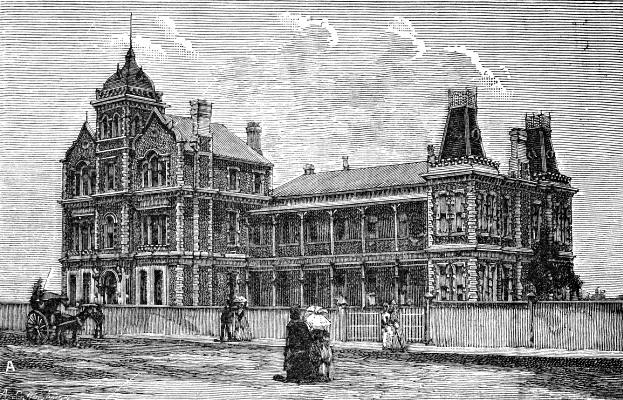Jonathan Stanway Parker: Mordialloc Pioneer 1826-1899
Little was known of the life and career of Jonathan Stanway Parker of Mayfield at Mordialloc until a concentrated search of genealogical records and public archives was undertaken for a recent report. [1] Of interest is the fact that the birth or christening of Jonathan Stanway Parker is not listed in the International Genealogical Index (IGI), however, a notation on the will and papers of Jonathan Stanway Parker confirms that he was born at Liverpool, England, on 27 February 1826.
A search of the 1851 Census records for Liverpool as prepared by the Liverpool and South West Lancashire Family History Society, unearthed only one reference to Jonathan Parker. Entry for household 504A suggests that Jonathan Parker was the son of Henry Parker, a grocer residing in the Castle Street and St Peters Ward with his wife and three children. This ward is close to the Custom House and the Liverpool docks, including the famous Alfred, Malthouse, Canning and George’s Docks. At the time of the 1851 census, Jonathan Parker, then aged 25 years, is recorded as living with his parents and his occupation is given as ‘provision dealer’.
Parker evidently emigrated to Australia in 1852, although his arrival has not yet been located in any of the of the unassisted immigration shipping indexes for Victoria and New South Wales in the period 1852-1879. J. S. Parker is not listed in any pre-gold rush directories for Melbourne and his name first appears in the Melbourne Commercial Directory, including Collingwood and Richmond, and Almanac for the Year 1853 as follows:
J. S. Parker, 31 Bourke Street West
Drapers and Outfitters and Hosiers [2]
Jonathan Parker purchased several large tracts of land at Mordialloc in the latter half of 1855, including Crown Allotment 2 of Section 23 at Mordialloc on 3 July (the Mayfield property) and Crown Allotments 20 and 10 of Section 24 at Mordialloc on 17 September and 10 December respectively. Allotment 20 consisted of 24 acres 3 rood and 18 perches while Allotment 24 measured 23 acres 1 rood and 38 perches in area. Parker held both these two lots for more than thirty years without seeking to subdivide them and it wasn’t until the height of the metropolitan land boom in 1888 that he contracted to sell the land (less a small section reserved for railway purposes) to the notorious auctioneer and land speculator, George William Taylor, for a consideration of £10,5000. Within four months, Taylor had entered into a contract of sale with Deakin and Bell as trustees of the Australian City and Suburban Investment & Banking Company Limited to sell the same land for an amount of £3,850,000.

Map showing land holdings in the Parish of Mordialloc.
Parker was a victim of G. W. Taylor’s unscrupulous behaviour and he twice took legal action against Taylor, firstly on 4 December 1889 to recover £5,251/12/4 and then on 24 April 1890 to recover £9,060/1/9 owing on his land at Mordialloc. At the time of the second action, Taylor was listed as residing in London. Louis Ellis, Sheriff, sold Crown Allotments 10 and 20 of Section 24 at Mordialloc back to J. S. Parker in a bargain sale held under a write of fieri-facias dated 11 June 1892. Parker then applied to bring the subject lands under the Transfer of Land Statute and to have title issue in his name [3] He held these properties until his death at sea in 1899.

George William Taylor.
Parker was recorded as living in Collingwood in September 1855 but was resident at Mordialloc by December of that year. By the time of compilation of the Victorian Electoral Roll for 1856, Jonathan S. Parker is listed as a yeoman (farmer) residing on freehold land at Mordialloc in the Oakleigh Division.
Parker arranged a mortgage of £300 over his Mayfield holding in July 1863 and it is likely that he built a five room single storey brick house on this property in the last months of 1863. Whilst this farmhouse is no longer intact, sufficient evidence survives to indicate that it was planned about a central axis with an encircling verandah across three elevations. J. S. Parker stayed on his farmstead until 14 July 1873, when he sold the large property known as Mayfield to Francis Louis Nompar De Caumount La Force, Count de Castelnau, otherwise the French Consul-General in Victoria. On the same day Count de Castelnau mortgaged the land to Jonathan Stanway Parker and this mortgage was in place until 11 July 1876, when it was discharged [4]. At the time of the sale of the Mayfield property, the Shire of Moorabbin rate book for 1873 records that J.S. Parker was the owner of a five room house standing on 536 acres, with a Nett Annual Value of £95.

Mayfield, 1999. Courtesy Stephen Calvert-Smith.
Parker’s movements are not clear after he moved from Mordialloc in July 1873 and it is possible that he returned to England for an extended period before coming back to Melbourne around 1877. He is recorded as residing in York Street West, Emerald Hill, in the 1878 edition of Sands and McDougall’s Melbourne Directory but is not listed in the alphabetical section in the previous year. In 1880 he was listed as residing at 47 York Street West. Emerald Hill and by 1895 he was resident at 64 Bridport Street West, Albert Park. The next year he moved to 402 Nott Street, Port Melbourne, his last known address in Melbourne.
The last will and testament of Jonathan Stanway Parker of 402 Nott Street, Port Melbourne, is dated 15 February 1899 and is preserved in the probate records held in the Public Records Office, Victoria. Parker appointed John Alexander Davies, miller, of Bridge Road, Richmond, and William Alford, commercial traveller, of 94 Nelson Road, South Melbourne, as his executors and trustees, his solicitors were Braham and Pirani of Trustees Chambers, 412 Collins Street, Melbourne. Jonathan Parker evidently made this will just prior to making a voyage to England in late February 1899 to visit his family and friends. His will makes no mention of any family living in Australia and it appears that he did not marry and had no issue in this country.
Parker made bequests of £100 each to Ada Cooke of Crewe Lodge near Crewe Station, Crewe, in the County of Cheshire, England, and to F. Fletcher of Grisby Terrance, Crewe, mother of Ada Cooke, with the stipulation that if Mrs Fletcher predeceased Jonathan Parker, then Ada Cooke was to get her mother’s share of his benefaction. J. S. Parker also made provision for separate bequests of £100 to the Homeopathic Hospital in St Kilda Road, Melbourne, and to the Melbourne Hospital for Sick Children in Pelham Street, Carlton. In addition, Parker provided a bequest of £100 each to the Church of Christ in Lygon Street, Carlton, and to the Church of Christ in Swanston Street, Melbourne. The balance of his real and personal estate was to be held in trust by his trustees for the benefit of the Foreign Mission Committee, the Training Committee and the General Evangelist Committee of the Churches of Christ in Australia.

Homeopathic Hospital, Melbourne c1888.
Parker never returned to Australia and his death is recorded in the ‘Marine Register Book of Deaths’ for 1900, entry 4122. This register entry confirms that Parker died from the ‘rupture of the aorta and associated haemorrhage into the pleural cavity’ at 2.30 pm on 12 December 1899 on board the White Star Liner steamer, Persic, and only five days after boarding the luxurious vessel at Liverpool for the passage to Melbourne via Cape Town. At the time of this death, the Persic was recorded as being in the Mid-Atlantic at Latitude 24° 14’ North, Longitude 14° West. Parker was buried at sea at 7.00 am on 13 December 1899 in the presence of Commander Inman Scalby, J Cunning, the ship’s surgeon who certified his death, and J. R. Welsh, the steward in charge. His death certificate gives no indication of his birthplace or his parents although it is recorded that he was a ‘widower’ with ‘no trace’ of any issue. The entry in the Victorian Marine Register Book of deaths was evidently transcribed from the ship’s log on 6 March 1900 and after the Persic had berthed at Port Melbourne.
The arrival of the White Star Liner S.S.Persic attracted considerable comment in the Melbourne press upon arrival at the Port Melbourne docks on Saturday 24 February 1900. The arrival was succinctly recorded in the shipping columns of the Argus on the following Monday:
ARRIVED FEB
24 Persic, S.S., 11973 tons, Inman Scalby, R.N.R., from Liverpool via Cape Town and ports. Dalgety and Co. Ltd., agents.WHITE STAR LINER PERSIC THE STEAMER
Persic, of the Liverpool White Star line, arrived in the bay on Saturday afternoon. This enormous vessel, which is almost a counterpart of her sister steamship, Medic and Afric, has had a protracted passage from Liverpool, owing to detention of Cape Town while repairs were effected to her rudder head. The requisite parts were procured from the builders of the Persic (Messrs. Harland and Wolff, Belfast), who also sent out a mechanic to Table Bay to expedite the work. The Persic, which is 11,973 tons gross register, was the sixth largest vessel launched from British ship-building yards in 1899, and has a cargo capacity of over 18,000 tons. The passenger accommodation, which consists of one class only, embraces improvements in details, which were suggested to the builders after the launching of the two mammoth vessels previously mentioned. The Persic, which brought 178 passengers for Melbourne and in transit for other ports, was berthed at the eastern side of the Port Melbourne Railway Pier, where she will put out about 2,1000 tons [of] cargo for here. Captain Scalby, who is in command, has with him as officers:- Messrs. F. Hart, chief; D. Evans, first; J.F. Wood, second; A. M. Leslie, third; A. H Ferris, fourth; G. A. Wright, chief engineer; E Lloyd, second; P, Adamson, third; J. R. Welsh, steward in charge; and J. Cunning, surgeon. [5]
A search of the Melbourne daily press over the period 12 December 1899 to 8 March 1900 and the Port Melbourne weekly Port Melbourne Standard for the period 24 February to 17 March 1900 has failed to locate either any announcement of the death of Jonathan Stanway Parker aboard the S.S. Persic or of his burial at sea. Likewise, a search of the Australian Christian, a weekly newspaper circulating amongst the Churches of Christ in Australia, New Zealand and Tasmania, over the period 4 January 1900 to 19 December 1901, failed to locate any obituary or other reference to the death of J.S. Parker.
The trustees of Jonathan Parker’s estate were both members of the Churches of Christ in Australia, with J.A. Davies holding the position of treasurer of the Victorian Conference for many years. William Alford was a foundation member of the South Melbourne congregation from its inception in 1867 and John A. Davies continued his membership of the Swanston Street church from the time of his arrival from New York in 1861 until his death on 22 May 1902. A biography of John A. Davies was published in A. B. Maston’s Jubilee Pictorial History of the Churches of Christ in Australasia, 1903, William Alford is mentioned in connection with the history of the South Melbourne church but there is no reference to Jonathan Stanway Parker at all in this comprehensive jubilee publication.
This exclusion is all the more remarkable as examination of the probate administration papers and statement of accounts reveals that Parker left most of his real and personal estate, which was valued at £6,676 odd for duty purposes, to the Churches of Christ in Australasia. At the time of his death in December 1899, J. S. Parker owned the following freehold property in Victoria.:
- Land at Mordialloc (24 acres 3 roods 23.6 perches) being allotment 20, Section 24, Parish of Mordialloc, with a wide frontage to beach Road and having ‘little value for cultivation but a very fine site for a gentleman’s mansion-seaside residence’. Valued at £40 per acre or £995/18/0. [6]
- Land at Mordialloc (20 acres 3 roods 34 perches) being Allotment 10, Section 24, Parish of Mordialloc, ‘but without the advantage of a sea frontage’. Valued at £314/8/9. [7]
- Cottages and land, York Street, South Melbourne, being part Crown Allotment 2, Section 3, City and Parish of South Melbourne, upon which stands two small brick cottages in poor condition, overlooking the Corporation store yard and market, and let at 6 shillings per week. This property was purchased by Parker on 19 August 1880. Valued at £300. [8]
- Cottage and land, City Road, South Melbourne, being part of CA 5, Section 51, City and Parish of South Melbourne, with a five room brick cottage in a ‘good position on a tram route’ and let at eleven shillings per week. This property was purchased by Parker from the fourth Victoria Permanent Building Society on 13 April 1896. Valued at £350. [9]
- Land at Pickles Street and Danks Street, Albert Park, being CA 38, Section 43, City and Parish of South Melbourne otherwise described as vacant land near the Gas Works ‘only suitable for workmen’s cottages’. J. S. Parker acquired this property on 16 December 1884. Valued at £139/10/0. [10]
His total real and personal estate, which included Victorian government debentures to the value of £4,012, was assessed at being £6,600 odd. Parker’s executors and trustees were quick to realise his assets and a review of the relevant title particulars confirms that most of the above mentioned property was sold by 5 July 1901 and the proceeds thereafter distributed to the various beneficiaries stipulated in J. S. Parker’s will. Enquiries of officers of the Churches of Christ in Melbourne has failed to locate any further data concerning Parker’s bequests to the church.
Footnotes
- Willingham, Allan, Mayfield at Mordialloc: A Cultural History and Documentation of the Fabric at 262 Lower Dandenong Road, Mordialloc 3195, 2002. Prepared for Specialised Vibrated Concrete Company Ltd.
- Melbourne Commercial Directory including Collingwood and Richmond and Almanac for the Year 1853, page 46.
- Certificate of Title Volume 2586 Folio 017.
- Certificate of Title Volume 608 Folio 494.
- Argus, February 26, 1900.
- Certificate of Title Volume 2586 Folio 017.
- Certificate of Title Volume 2586 Folio 017.
- Certificate of Title Volume 1193 Folio 589.
- Certificate of Title Volume 2536 Folio 046.
- Certificate of Title Volume 1676 Folio 025.
